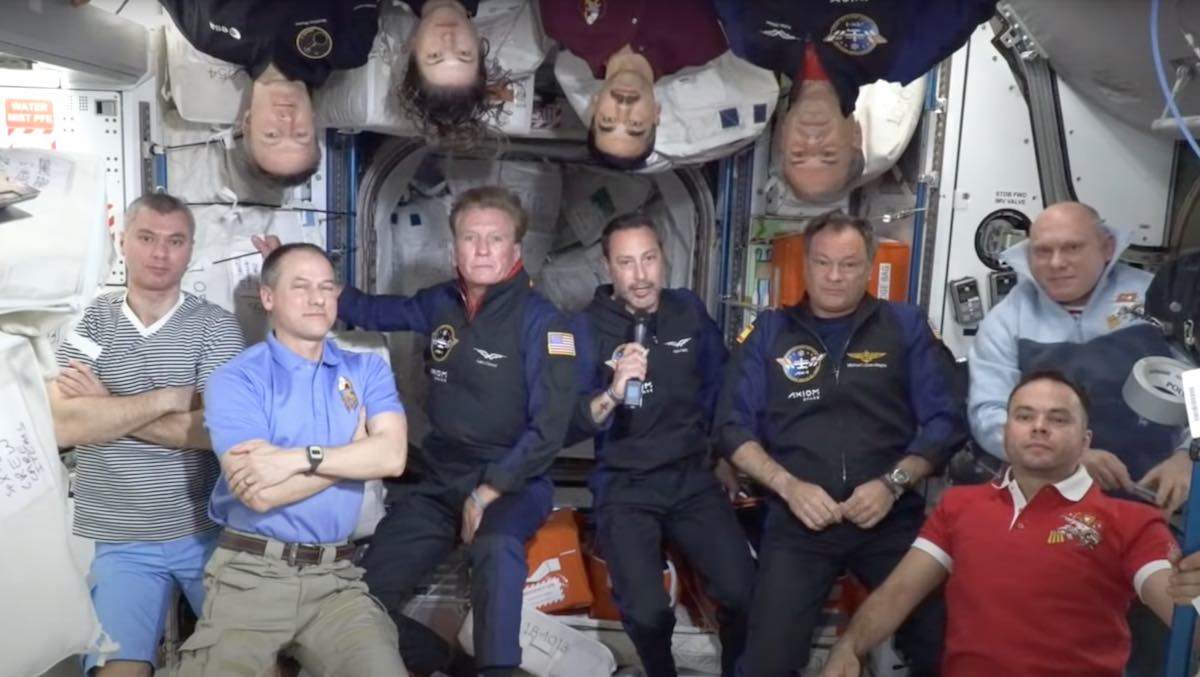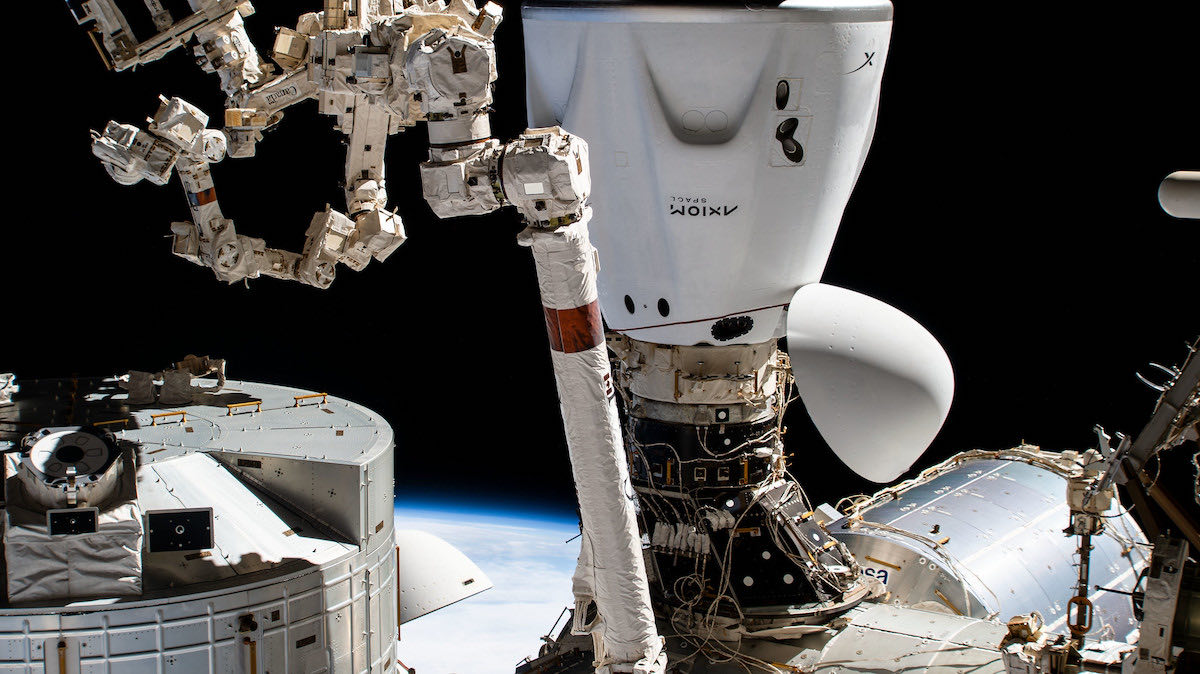
The four-man crew flying on Axiom’s first private mission to the International Space Station is getting some extra time on the orbiting complex this week. Managers have extended their stay until at least Thursday night due to bad weather in SpaceX’s splashdown zones off the coast of Florida.
The Axiom crew, which arrived at the station April 9 aboard SpaceX’s Dragon Endeavour spacecraft, was supposed to undock from the outpost Tuesday morning and head for a parachute-assisted splashdown Wednesday morning. But ground teams waved off that departure opportunity because of unfavorable weather at the return site.
Officials decided Tuesday to forego an undocking late Tuesday night, which would have led to a splashdown Wednesday afternoon.
“The integrated NASA, Axiom Space, and SpaceX teams are continuing to assess the next best opportunity for return of the first private astronaut mission to the orbiting laboratory based on weather conditions and space station operations,” NASA said in a post on its website.
NASA’s mission control radioed the space station crew early Wednesday that the earliest opportunity for the Axiom mission, known as Ax-1, to undock from the complex would be around 8 p.m. EDT Thursday (0000 GMT Friday). But that assumes good weather in the recovery zones in the Gulf of Mexico or the Atlantic Ocean.
SpaceX has seven splashdown locations available off Florida’s East Coast and Gulf Coast. The company monitors for wind speeds, wave height and period, lightning, and rainfall before determining if conditions are acceptable for a safe crew return. At least two sites must have “go” conditions forecast before a crew undocks from the space station.
The delays in returning the Ax-1 crew will likely push back the launch of the next long-duration crew to the space station. That mission, designated Crew-4, is scheduled to launch on SpaceX’s Dragon Freedom spacecraft — another vehicle in SpaceX’s fleet — from NASA’s Kennedy Space Center no earlier than 5:26 a.m. EDT (0926 GMT) Saturday.
But SpaceX and NASA require a couple of days between the return of a Dragon crew capsule and the launch of the next Dragon astronaut mission. The Crew-4 mission has backup launch opportunities extending into next week.
The Crew-4 mission is set to begin a nearly five-month expedition on the International Space Station, replacing the outgoing team of Crew-3 astronauts who have been on the station since November. After a handover with the Crew-4 astronauts lasting nearly a week, Crew-3 mission is scheduled to undock from the station in SpaceX’s Dragon Endurance spacecraft around April 30 for return to Earth.

The Ax-1 mission is commanded by Michael López-Alegría, a retired NASA astronaut and now an employee of Axiom Space, the Houston-based company managing the private astronaut flight. The other crew members for the Axiom mission are pilot Larry Connor and mission specialists Eytan Stibbe and Mark Pathy, three investors and entrepreneurs who paid for their rides.
López-Alegría and his crewmates launched April 8 from the Kennedy Space Center. SpaceX’s Dragon Endeavour spacecraft completed the 21-hour pursuit of the space station for an automated docking April 9.
During their time in space, the Ax-1 crew members have performed research experiments and participated in public outreach and educational events with organizations on the ground. The mission is an all-commercial affair, and is the first of its kind.
“We were able to accomplish our objectives and hopefully it will lead to some great groundbreaking research,” Connor said. “Also, too, we conducted as a team over 15 educational outreach to youth all across the world, not just in the United States. So hopefully that will make a positive impact on the next generation. And if you ask me, well, what’s the experience been like? Exhilarating and unique.”
Previous visits by private astronauts, or “space tourists,” to the space station occurred on government-led missions on Russian Soyuz spaceships. Before Ax-1, 11 people had traveled to the space station as paying passengers on Soyuz missions, but they all flew with a government cosmonaut commander.
Axiom contracted with SpaceX for the Falcon 9 launch and the Dragon flight to the space station. Axiom also has an agreement with NASA, which is providing accommodations for the four-man crew at the station.
The cost of the Ax-1 mission has not been released, but NASA’s inspector general has estimated the price of a seat on a SpaceX Dragon spacecraft at about $55 million. Axiom is also paying NASA for crew accommodations, such as access to the station’s life support system, food, and toilet, but the company is getting a discount in exchange for bringing home NASA’s experiment samples and research equipment on the Dragon Endeavour spacecraft.
“This is such a big, historic time for us, simply because the Axiom–1 crew is opening the door,” said Tom Marshburn, a NASA astronaut and commander of the crew on the International Space Station. “We hope future private astronaut missions will continue to open the door to more spaceflights, getting more people into space, getting more science done on the space station. And we feel like this is going to be the way things are for the decades to come, and we’re really looking forward to it.”
“I think I could speak for all of us, it’s been an amazing experience,” López-Alegría said Tuesday. “A few adjectives may be unique, certainly magnificent and to some degree humbling. But I think more than anything very, very rewarding.”
López-Alegría is on his fifth mission to space after previous launches on NASA’s space shuttles and Russia’s Soyuz spacecraft.
“This really begins a new era of human spaceflight, where people other than just government astronauts, who are obviously very professionally trained and prepared, can come up with a little bit less training, but still able to function in this very unique and sometimes challenging environment,” López-Alegría said. “And I think that is sort of a first step toward a real democratization of this experience.
“It’s going take a while because the prices obviously are quite high now, but we think that in the future this will be something that we can share with more and more parts of humanity, and we’ll make humankind all the better for it.”
Email the author.
Follow Stephen Clark on Twitter: @StephenClark1.
